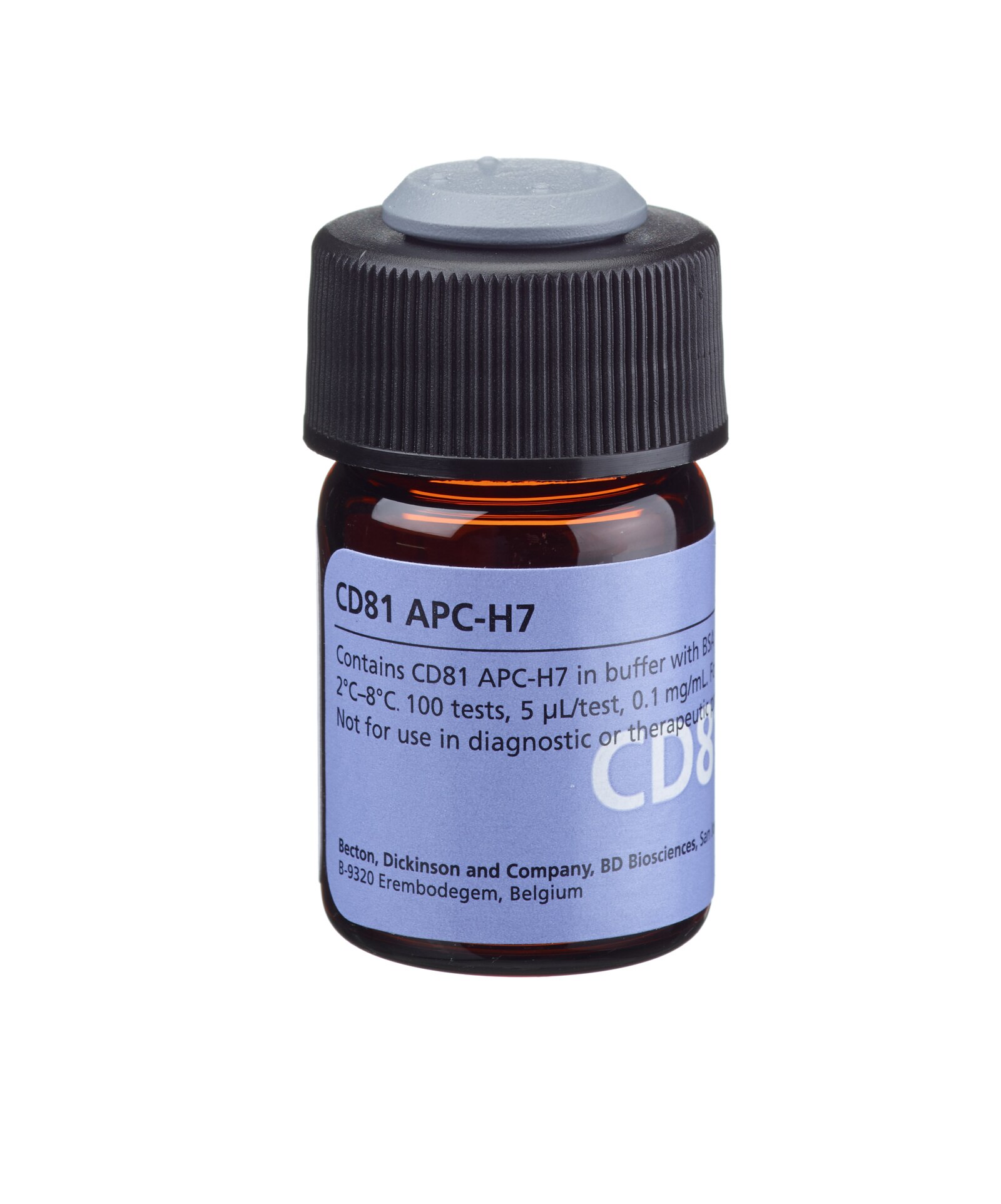Old Browser
Looks like you're visiting us from {countryName}.
Would you like to stay on the current country site or be switched to your country?


Regulatory Status Legend
Any use of products other than the permitted use without the express written authorization of Becton, Dickinson and Company is strictly prohibited.
The CD81 antibody, clone JS-81, is derived from hybridization of P3/NS1/1-Ag4-1 mouse myeloma cells with spleen cells isolated from mice immunized with the Burkitt lymphoma cell line, Ramos.
The CD81 antibody recognizes a 26-kilodalton (kDa) member of the tetraspanin family (TM4SF). The CD81 antigen is also known as TAPA-1.

Development References (12)
-
Bradbury LE, Kansas GS, Levy S, Evans RL, Tedder TF. The CD19/CD21 signal transducing complex of human B lymphocytes includes the target of antiproliferative antibody-1 and Leu-13 molecules. J Immunol. 1992; 149(9):2841-2850. (Biology). View Reference
-
Centers for Disease Control. Update: universal precautions for prevention of transmission of human immunodeficiency virus, hepatitis B virus, and other bloodborne pathogens in healthcare settings. MMWR. 1988; 37:377-388. (Biology).
-
Clinical and Laboratory Standards Institute. 2005. (Biology).
-
Fearon DT, Carroll MC. Regulation of B lymphocyte responses to foreign and self-antigens by the CD19/CD21 complex. Annu Rev Immunol. 2000; 18:393-422. (Biology).
-
Flint M, Maidens C, Loomis-Price LD, et al. Characterization of hepatitis C virus E2 glycoprotein interaction with a putative cellular receptor, CD81. J Virol. 1999; 73:6235-6244. (Biology).
-
Levy S, Todd SC, Maecker HT. CD81 (TAPA-1): a molecule involved in signal transduction and cell adhesion in the immune system. Annu Rev Immunol. 1998; 16:89-109. (Biology). View Reference
-
Oren R, Takahashi S, Doss C, Levy R, Levy S. TAPA-1, the target of an antiproliferative antibody, defines a new family of transmembrane proteins. Mol Cell Biol. 1990; 10(8):4007-4015. (Biology). View Reference
-
Pesando JM, Hoffman P, Conrad T. Malignant human B cells express two populations of p24 surface antigens. J Immunol. 1986; 136:2709-2714. (Biology).
-
Petracca R, Falugi F, Galli G, et al. Structure-function analysis of hepatitis C virus envelope-CD81 binding. J Virol. 2000; 74:4824-4830. (Biology).
-
Takahashi S, Doss C, Levy S, Levy R. TAPA-1, the target of an antiproliferative antibody, is associated on the cell surface with the Leu-13 antigen. J Immunol. 1990; 145:2207-2213. (Biology).
-
Tedder TF, Wagner N, Engel P. Schlossman SF, Boumsell L, Gilks W, et al, ed. Leukocyte Typing V. White Cell Differentiation Antigens. New York, NY: Oxford University Press; 1995:684-688.
-
van Zelm MC, Smet J, Adams B, et al. CD81 gene defect in humans disrupts CD19 complex formation and leads to antibody deficiency. J Clin Invest. 2010; 120:1265-1274. (Biology).
Please refer to Support Documents for Quality Certificates
Global - Refer to manufacturer's instructions for use and related User Manuals and Technical data sheets before using this products as described
Comparisons, where applicable, are made against older BD Technology, manual methods or are general performance claims. Comparisons are not made against non-BD technologies, unless otherwise noted.
For Research Use Only. Not for use in diagnostic or therapeutic procedures.
Refer to manufacturer's instructions for use and related User Manuals and Technical Data Sheets before using this product as described.
Comparisons, where applicable, are made against older BD technology, manual methods or are general performance claims. Comparisons are not made against non-BD technologies, unless otherwise noted.
Report a Site Issue
This form is intended to help us improve our website experience. For other support, please visit our Contact Us page.